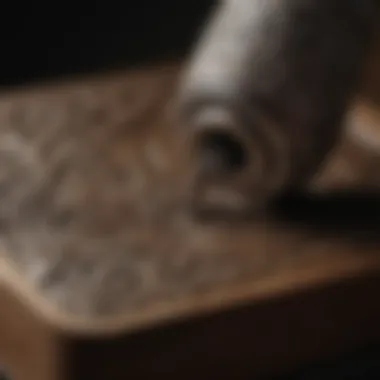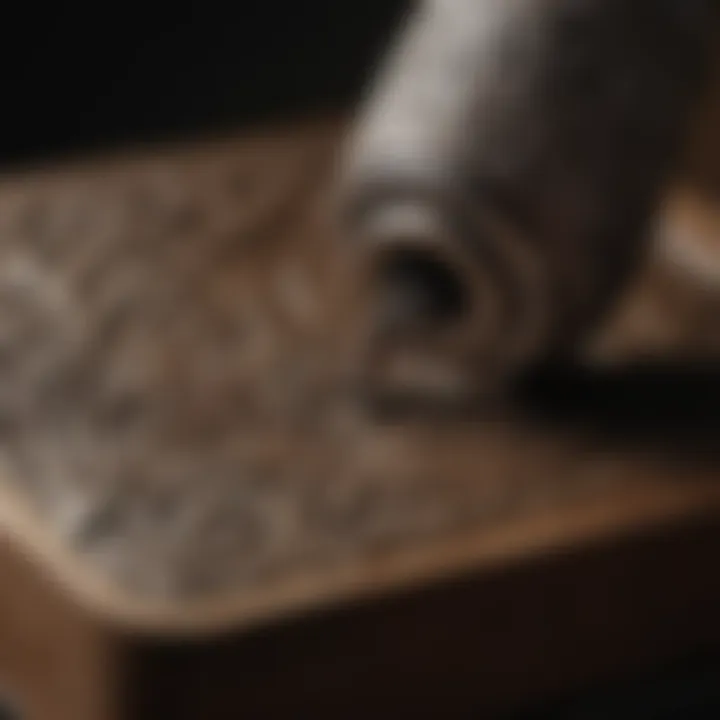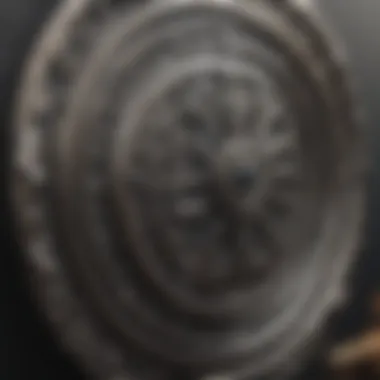Mastering Dremel Engraving: Essential Tips Unveiled


Intro
Dremel engraving is a craft that bridges artistry and precision. It provides homeowners, artists, and hobbyists the opportunity to customize and personalize a variety of materials. With the right tips and techniques, you can enhance the aesthetic quality of your projects and surroundings. Using a Dremel tool, you can create intricate designs on surfaces like wood, glass, metal, and plastics, making it a versatile choice for many.
Overview of Topic
Engraving refers to the creation of designs or texts on different surfaces. The Dremel tool excels in this area due to its variety of attachments and speed settings. With these features, skills needed to operate the tool vary from beginner to expert level. In the home improvement industry, this type of engraving is crucial. It allows homeowners to add personal touches to their possessions which can increase the overall value and aesthetic appeal of their homes.
- Why It Matters: Enriching your space with bespoke engraving does more than beautify; it demonstrates a degree of craftsmanship that can impress family, friends, and guests. Personalization also fosters a sense of uniqueness and pride in one’s home environment. Engraving can transform ordinary objects into extraordinary pieces of artwork.
Common Challenges and Solutions
Challenges: Using Dremel tools for engraving has common challenges. Beginners might find it hard to maintain steady hands, leading to uneven lines. Moreover, unequal pressure during the engraving process can cause tool wear or unwanted design variations.
Solutions:
- Practice: Start with soft materials. This makes it easier to control your tool.
- Support: Using a clamp or fixing your object can help keep things steady.
- Take Breaks: This can prevent fatigue, which leads to loss of precision.
- Adjust Speed: Tailor the tool’s speed based on the material being worked on. Higher speeds work well on softer materials like wood, while slower speeds are better on glass and harder materials.
Product Recommendations
In considering the Dremel brand, Dremel 4000 is a standout option. This model includes the following benefits:
- Versatile Speed Control: Ranges from 5,000 to 35,000 RPM, letting you tackle various engraving tasks.
- Comfortable Design: Specifically crafted for long work sessions with reduced vibrations.
- Attachable Accessories: Outfitted with a selection of bits that can suit diverse engraving styles.
Dremel Lite 7760 is another notable mention, ideal for beginners:
- Compact and Lightweight: Easy to handle, making it great for intricate detailing work.
- USB Rechargeable: Convenient for those without access to direct electrical outlets.
- Safety Features: Built to prevent overheating, making it a reliable choice for novices.
Step-by-Step Guides
Approach engraving with a methodical plan:
- Select Your Material: Choose material based on your desired outcome. Wood is forgiving, while glass requires a steadier hand.
- Plan Your Design: Sketch your design first. Practice on paper can encourage smoother execution on the real material
- Set Up Your Tool: Adjust the Dremel tool’s speed as suited for your material using the adjustable settings regulator.
- Secure Material: Use clamps or a vice to make certain the material does not move during engraving.
- Begin Engraving: Follow your design closely. Keep a consistent pace and apply uniform pressure. Regular pauses can help maintain accuracy.
Following these steps can help ensure the process does not rush and outcomes produce the expected results.
Tip: Regular tool maintenance increases longevity and functionality. Keep your Dremel clean and follow manufacturer's guidelines for storage and part replacement.
With patience and practice, engraving with a Dremel can become an enjoyable and rewarding hobby. Future sections will elaborate further in detail on essential techniques and safety measures to sustain your artistic journey.
Preface to Dremel Engraving Tips
Engraving with a Dremel tool can bring out the detail in objects and create personalized items. Understanding how to use Dremel engraving tips effectively becomes essential for achieves beautiful results. This tutorial organizes essential information concerning these tools into easily understandable sections.
What is a Dremel Tool?
A Dremel tool is a rotary tool branded under Dremel, specifically designed for precision work. It features a high-speed motor that drives various attachments. These attachments include cutting wheels, polishing pads, and, importantly, engraving tips. Because of its versatility, a Dremel can engrave on numerous materials including wood, metal, and glass.
The design aims to provide control and precision, facilitating users to work with delicate designs. Although often associated with amateur crafts, this tool's application extends to professional works, proving essential in many workshops.
Purpose of Engraving Tips
Engraving tips are specialized attachments that enable the Dremel tool to carve into surface materials. These tips come in various shapes and sizes, each tailored for specific tasks. Using engraving tips enhances detail and intricacy, allowing one to achieve clean and clear designs on projects.
While a standard rotary attachment performs simple tasks, engraving tips provide dimension and precision. Thus, they extend the tool's capability, allowing you principally to add artistic flair to jewelry or create elegant designs on wood.
Adding both similar and distinct angles in performance, engraving tips prove essential when executing a design.
Tip: Langeld intentions with engraving carefully—set a steady base before starting. Mistakes can be difficult to correct!
Types of Dremel Engraving Tips
Understanding the types of engraving tips is essential for effectively using a Dremel tool. Each type of engraving tip brings its own unique benefits and application considerations. When one starts a project, choosing the correct tip can significantly affect the outcome. The performance of the tool, the material being engraved, and the finish that one seeks all hinge on the precise type of tip used. Thus, recognizing the differences is far more than just an academic exercise; it is pivotal for achieving professional results.
High-Speed Steel Tips
High-Speed Steel tips are widely recognized for their versatility and utility. These tips are often less expensive compared to other types, making them attractive to novice users or hobbyists who are starting without investing heavily. They work admirably for lighter engraving tasks and soft materials like wood or leather. However, they do dull faster, which necessitates a careful consideration of project type.
The edges of high-speed steel tips can be sharpened a few times, extending their usability, sort of how one would sharpen a kitchen knife. Although suitable initially, repeated use on tougher materials can result in hastily losing that sharpness. For those who explore more challenging materials in the future, testing the high-speed steel tips will present either a learning curve or a segue into higher-quality options.
Carbide Tips
Carbide tips offer better durability compared to high-speed steel, making them suitable for users who frequently work on harder materials. With an even higher resistance to wear and heat, these tips accomplish intricate tasks effectively. They are functional for engraving on hard wood, metals, and some plastics without the risk of rapid decline in performance.
The cost of carbide tips may be elevated than that of their high-speed steel counterparts, but many users find them ultimately worthwhile due to efficiency and longevity. Care should be taken, however. Even with their solid performance, excessive force can cause breakage, which can inhibit overall project fluidity.
Diamond Tips


Diamond tips present the pinnacle in terms of durability and longevity. Embedded with diamond particles, these tips execute precision holds on some of the toughest materials such as ceramics and glass. They allow users to explore avenues that lower-grade tips cannot adequately satisfy. Events could range from small glass etchings to substantial engraved surfaces.
The investment for diamond tips exists at the higher end of the spectrum, but they yield operating costs that could significantly outweigh those for other types. Users can confidently tackle demanding projects with minimized worry about selecting a proper tip. When precision engravings are essential, and favorable durability is required, diamond tips will likely serve best.
By comprehending the distinctive elements among high-speed steel, carbide, and diamond tips, one cultivates a deeper knowledge base enabling more effective project planning and execution.
Comparative Analysis of Engraving Tips
Analyzing different types of engraving tips is crucial for achieving the desired results in your projects. Understanding the specific features and advantages of each type enables users to make informed decisions tailored to their materials and needs. Factors like durability and precision hold great importance in engraving work. The right choice can lead to better outcomes, offering both satisfaction and efficiency in the work process.
Durability
Durability in engraving tips ensures that they last through multiple projects without needing frequent replacements. This is particularly relevant for home users, who may engage in various engraving crafts. High-speed steel tips tend to wear down more quickly on harder surfaces compared to carbide tips. Carbide, on the other hand, offers superior longevity, making them suitable for prolonged use. In contrast, diamond tips are particularly durable, especially when used on abrasive materials like glass or ceramic.
Factors affecting the durability of engraving tips include:
- Material Composition: The choice of material plays a large role. Carbide tips are recognized for their resilience.
- Frequency of Use: Engraving consistent projects without excessive pressure will enhance longevity.
- Type of Surface: Softer materials may lead to less wear, extending the life of the tips.
Protecting your investment in engraving tools through informed choices will ensure that projects remain enjoyable and productive.
Precision
Precision is paramount when it comes to engraving tasks. Fine details can be lost if the wrong tip is used, leading to unsatisfactory results. Different tips offer varying levels of precision, creating unique advantages and challenges.
- High-Speed Steel Tips: While usually dull after a few uses, they can provide defined lines on soft materials. However, this definition cannot be maintained for many details.
- Carbide Tips: Known for maintaining sharpness while providing finer control, these tips allow for more intricate designs. Their effectiveness on wood, for instance, makes them favorites among Nurseries!
- Diamond Tips: These tips shine notably in precision, particularly regarding glass. They create clear, crisp engravings due to their fine grit.
Achieving precision often relies on practice and adjustment to suit the engraving medium. The more you engage with these tips, understanding how they behave, the more prepared you will be to handle complex tasks.
Understanding the nuances between engraving tips can significantly impact project quality and engagement, guiding your decisions toward optimal outcomes.
Choosing the Right Engraving Tip
Choosing the correct engraving tip is crucial for successful projects when using a Dremel tool. The right tip can make a significant difference between a polished, smooth finish and an uneven or unsatisfactory result. When selecting your engraving tip, it is important to consider various elements that cater specifically to the material you will work with and your desired project specificity. A logical approach will help in enhancing precision while also ensuring the durability and quality of your final work.
Material Considerations
Different materials require distinct engraving tips. Steel tips excel on harder surfaces, such as metals like aluminum or brass, due to their strength and ability to maintain sharp edges. The carbide tips, on the other hand, are more versatile, functioning well when engraving into wood, soft metals like copper, and plastic. They offer durability yet provide ease during operation.
Diamond tips hold remarkable utility as well. These are best suited for tougher surfaces like glass or ceramics. They create fine detail while reducing the risk of chipping or cracking delicate surfaces.
Here are key material considerations to keep in mind:
- Hardness of Material: Understand the material hardness before you choose the tip.
- Desired Finish: Decide if you seek smooth or precise patterns, as this impacts the choice of tip types.
- Tip Type Compatibility: Ensure the tip’s design accommodates standard engraving practices for your specified material.
Ensuring the right tip for the right material not only achieves immediate success in engraving tasks but also extends the lifespan of the tips through less wear and tear over time.
Project Specificity
Every project possesses unique demands. Understanding the specific nature of your engraving task plays a vital role when making your choice. For simplistic designs, high-speed steel tools might suffice, but for intricate work, such as detailed jewelry pieces or decorative engravings, an appropriate diamond tip could ensure unparalleled accuracy.
Here are a few project-specific guidelines to follow:
- Technical Complexity: An intricate design often necessitates finer tips for better control.
- Depth Requirement: Certain projects need varying depths for engravings—assess this before selecting your tip type.
- Time Investment: Determine how detailed the project will be, and choose tips that match both the timeframe you have and the results you want to achieve.
Recommendation: Evaluation of your project’s needs ahead of time can prolong the quality of the engraving and help avoid any unwanted mistakes during the process.
Applications of Dremel Engraving Tips
Understanding the applications of Dremel engraving tips provides valuable insights into the versatility and functionality of these tools. Engraving has transitioned from a straightforward craft to a precise art form. With Dremel engraving tips, users can navigate a wide array of tasks, creating intricate designs or practical engravings across various materials. The benefits are numerous, extending from personal expression in crafts to professional utilization.
Jewelry Making
Jewelry making is a renowned application for Dremel engraving tips. Crafting custom pieces allows hobbyists and professionals to add personal touches that sets their work apart. With fine precision, artisans can engrave patterns, names, or designs on materials such as silver, gold, or brass. This application enables one to create bespoke items that resonate personally with clients or for artist’s own collection.
Engraving tips made from hard materials, such as diamond or carbide, are especially beneficial when working with metals. They help produce clean lines and intricate details necessary for jewelry.
Factors to consider when engraving jewelry include:
- Material selection: Choosing the correct metal will influence the required tool and technique.
- Depth of engraving: Knowing how deep to engrave will impact the finish, making the piece more elegant vs. a bold statement.
- Design complexity: This should align with the engraver's skill level and the tool’s capabilities.
Woodworking
Woodworking also showcases the capabilities of Dremel engraving tips significantly. Whether it is intricate designs on furniture or branding logos on wooden pieces, engraving enhances the appeal and functionality of wood products. Engraving provides an attractive layer of decor as well as practical marker brands for artisans.
Preferred tips for woodworking tasks are generally high-speed steel and carbide beats due to their durability and sharpness. They allow for quick removal of material, making detailed engravings simpler and more efficient.
When using engraving tools in woodworking, take considerations in mind:


- Type of wood: Different woods react uniquely to engraving; softer woods are easier but may lack detail retention.
- Finish application post-engraving: Consider sanding or sealing the engraved area to enhance appearance and prevent splintering.
- Design alignment: Ensure proper placement for an effective, cohesive look.
Glass Engraving
Engraving glass presents its unique challenges and rewards. With the proper tips, Dremel engravers can produce detailed designs on various glass surfaces, ranging from decorative items to functional kitchenware. This ability to add character and beauty alters ordinary glass items into visually stunning specifications.
For effective glass engraving, diamond or carbide tips are optimal. These tips provide the right point of hardness to create clean designs.
Consider these factors when venturing into glass engraving:
- Surface preparation: Clean the glass thoroughly to avoid scratches during engraving.
- Tool speed: Opt for slower speeds to minimize chipping that may occur with the high speeds.
- Stability: Strongly secure the workspace to ensure accurate punches which reflect on end quality.
Engraving is not just a craft; it's a way to memorialize memories and messages in everyday objects.
Dremel engraving tips thus present endless possibilities. Understanding their applications leads to activism and artistry across different materials, whether in personal projects or professional enterprises. Both the creative benefits and performance-enhanced results augment the desire to explore engraving further.
Techniques for Effective Engraving
Engraving with a Dremel tool can be quite satisfying, but to truly harness its potential, one must employ proper techniques. This will ensure not just a polished finish, but also a safe operation. Focused skills such as controlling pressure and managing speed are central to achieving desired engraving results. Let us dive into two key practices that can tremendously impact the engraving experience.
Maintaining Steady Pressure
Consistency is vital in engraving. Unsteady hands can lead to uneven depths, which might spoil the desired design. Applying steady pressure ensures that the engraving tip makes uniform contact with the material. This results in engravings that are even and aesthetically pleasing.
To maintain a balanced grip:
- Choose the Right Stance: Stand or sit in a comfortable position that allows your arms and hands to stay firm.
- Use a Guide: If beginners, consider using a piece of tape or a ruler. This provides both a visual guide and a physical push against which to engrave.
- Practice: Before starting on your final piece, practice on a scrap material to gauge the feel of pressure. Doing this can greatly enhance your confidence and control during the actual engraving.
It’s critical to remember that pressure doesn’t equal excess force. Pressing too hard can damage the engraving tip, leading to earlier deterioration and ineffective results.
Maintaining a light yet confident pressure is key. Focus on technique over brute force.
Speed Control
Every Dremel engraver should understand the impact of speed. Too much speed will often result in tears and jagged edges in softer materials, while too little might lead to inefficient engraving. Adjusting the speed according to the material type and engraving depth needed can enhance precision across different projects.
For easy speed control:
- Know Your Material: Different materials require different speeds. For instance, harder materials like metals need higher speeds, while softer materials like wood may perform better at lower speeds.
- Adjusting Settings: Most Dremel tools feature adjustable speed settings. Start at a lower setting and increase gradually to find what works best.
- Listen to Your Tool: Often, the sound of your Dremel can inform you if it’s working too hard or at optimal function.
By mastering speed adjustments, engravers can be more creative in their designs while ensuring quality work. It will reflect well in all your finished pieces.
With these techniques in mind, the path to mastering Dremel engraving becomes clearer. Maintain pressure control and speed adjustments to create stunning results.
Safety Precautions
Understanding safety precautions when using Dremel engraving tips is critical for both novice and experienced users. These measures prevent injuries and ensure a flawless engraving experience. Safety is not simply an afterthought; it is paramount to achieving effective results while minimizing the risk of accidents.
Protective Gear
Using protection gear while engraving is non-negotiable. At minimum, you should invest in high-quality safety glasses to protect your eyes from debris created during the engraving process. Additionally, wearing a dust mask is recommended. This helps to avoid inhaling potentially harmful particles or dust produced during engraving, especially when working on wood or glass materials.
Safety gloves offering a tactile fit can also add an extra level of security. Although a convenient grip is essential, don’t opt for loose gloves that might get caught in the tool. Nonetheless, check for protective clothing that remains durable while allowing you freedom of movement will enhance your ability to focus on the work itself.
“Personal protection is crucial when using power tools; it can mean the difference between a minor inconvenience and a serious accident.”
Workspace Preparation
Your workspace is the next factor to consider for safety. A cluttered space increases the likelihood of accidents. Begin by ensuring that your workspace is clear of unnecessary tools or materials. Keep your Dremel and its tips organized and readily available, promoting efficiency.
Assess the surface you work on; it should be stable and level. Ideally, it would be wise to use a workbench that can adequately accommodate your projects. Ensure that there is sufficient light in the area so you can see what you are doing without straining your eyes.
Also, think about any flammable materials nearby. Move them to a safer distance, especially because some engraving may produce heat and sparks. Having a fire extinguisher nearby is a prudent precaution. Overall, environmental considerations play a key role—pay attention to ventilation, especially when working with plastic or resins that can emit fumes.
By ensuring that protective gear is used and your workspace is appropriately prepared, you minimize hazards associated with Dremel engraving, thus assuring safer practice for all involved.
Maintenance of Dremel Engraving Tips
Maintaining Dremel engraving tips is crucial for ensuring their longevity and performance. Proper upkeep can lead to more efficient operations and improved engraving quality. Users should be aware of the buildup of debris, regular wear and tear, and exposure to different materials, all of which require attention over time. When tips are well-maintained, they can provide cleaner lines and prevent deepening issues caused by ineffective tools.
Cleaning Tips
One of the primary aspects of maintenance involves cleaning the engraving tips. It is important not to overlook this step as it directly affects the functionality of the tool. Different materials might create residue on the tips, which can impede performance.


To clean your engraving tips, follow these practices:
- Regular Inspection: Check tips after every use. Inspect for debris buildups. Remove any visible material.
- Brushing: Use a soft-bristle brush to sweep away fine particles. This prevents clogging.
- Soaking: If residue is stubborn, immerse the tips in warm water. Use mild detergent for tougher substances. Avoid harsh chemicals.
- Dry Thoroughly: After cleaning, ensure the tips are dried properly to prevent corrosion.
These steps not only prolong the life of the engraving tips, but they also prepare them for future work, promoting consistent engraving quality.
Storage Practices
Proper storage of Dremel engraving tips cannot be emphasized enough. Storing tips haphazardly can lead to damage, which diminishes performance. It is essential to consider how and where engraving tips are kept.
Here are some effective storage methods:
- Dedicated Storage Box: Utilize a toolbox or a specific holder designed for Dremel tips. This prevents mixing or damaging individual tips.
- Labeling: Consider labeling the box or containers for quick reference and organization. This helps in finding the right tool faster.
- Avoid Moisture: Keep storage in a dry place. Humidity can lead to corrosion or rust.
- Temperature Monitoring: Store tips in a stable temperature area. Extreme heat or cold can affect the integrity of the materials.
By adhering to these storage practices, you ensure the Dremel engraving tips are ready for use whenever needed, maintaining their effectiveness and reducing the risk of premature wear and damage.
Troubleshooting Common Issues
Engraving is intricate and may involve overcoming various challenges. Understanding how to troubleshoot common issues ensures a smoother experience and ultimately leads to successful projects. This section focuses on two significant problems: inconsistent engraving depth and tip wear and tear. Properly addressing these matters enhances the quality of engraving while extending the life of your tools.
Inconsistent Engraving Depth
Inconsistent engraving depth can arise from multiple factors, affecting the final appearance of your work. Such variations may stem from applying uneven pressure, insufficient tool speed, or even choosing inappropriate materials. This inconsistency can detract from the overall quality, leading to a disjointed finish.
To mitigate this issue, you should focus on the following:
- Training your hand pressure: Keeping a steady grip fosters uniformity in engraving depth. It is beneficial to practice before beginning your main project.
- Adjusting tool speed: Each material may require different speed settings to ensure even cutting. Trial and error can help identify the optimal speed for your particular material.
- Inspecting your workspace: Ensure that your surface is stable. Any movement can cause sudden shifts in pressure during engraving.
By optimizing these aspects, you can achieve consistent results across your designs. Remember that practice plays a crucial role in mastering your technique over time.
The key to engraving lies in understanding how various factors combine to affect depth and quality.
Tip Wear and Tear
All tools experience wear and tear with continued usage, including Dremel engraving tips. As they degrade, performance decreases, leading to poor engraving quality. Recognizing the signs of significant wear allows for timely replacements or maintenance.
Some signs of tip wear and tear include:
- Visual abrasion: If the tips have visible nicks or shiny areas, this could indicate metal fatigue.
- Ineffective engraving: If you notice uncharacteristic dragging or skipping during operation, it may suggest the tip is no longer effective at achieving cuts.
- Increased heat: Overheated tips can transfer unwanted heat to materials, causing deformation.
To combat wear, ensure you are:
- Using the appropriate speed settings.
- Regularly cleaning tips after use to prevent buildup.
- Storing them properly to avoid accidental damage.
Addressing these signs of wear helps maintain the effectiveness of your Dremel tips and achieves excellent results consistently.
Future Trends in Dremel Engraving Technology
Understanding the future trends in Dremel engraving technology is essential for users who aim to stay relevant and utilize their tools to the fullest. As technology evolves, engraving techniques, materials, and tools see significant advancements. Knowing these trends helps hobbyists and professionals alike to enhance their creativity and precision.
Advancements in Materials
The materials used for Dremel engraving tips have advanced notably in recent years. New alloy composites and ceramics offer significant durability and performance. For instance, carbide-tipped engraving tools last longer and withstand more heat compared to standard steel.
Benefits include:
- Increased longevity, resulting in reduced replacements during projects.
- Enhanced precision, ensuring finer and cleaner engravings.
- Light-weight materials, offering comfort during extended use.
Such advancements foster innovation among crafters. Users are now able to experiment with new textures and patterns, pushing their creative limits further than traditional materials would allow.
Integration of Technology
With the rise of digital tools and software, integration into Dremel engraving technology enhances user experience. Computer-aided design (CAD) software can now formulate engravings, interfacing directly with engraving tools
Some important features are:
- Automation: Programmable engravers let users save designs while allowing them to create intricate details that would be unmanageable manually.
- Precision: Digital drawings translate to sharper engravings, reducing the likelihood of human error signficantly.
- Ease of Learning: New software becomes more user-friendly, paving the usage for even beginners to feel more in control.
Ending
Summarizing the insights presented in this article, it crucial to acknowledge the multifaceted aspects of Dremel engraving tips. Engraving can execute extraordinary results when paired with an understanding of suitable engraving tips related to different materials. The choice between high-speed steel, carbide, and diamond tips determines the precision, speed, and quality of the outcome.
Recap of Key Points
- Types of Engraving Tips: Each tip type serves different functions and durability. Selecting the correct one is foundational.
- Applications: From jewelry making to woodworking and glass engraving, the appropriate use broadens creative avenues.
- Techniques and Maintenance: Adjusting techniques like pressure and speed enhances outcomes while regular maintenance ensures lasting quality of tools.
- Safety: Protective gear paired with an organized workspace prevents common accidents during the engraving process.
- Future Trends: Innovations confirming various advancements will enhance the effectiveness of Dremel engraving.
Final Thoughts
Engraving with a Dremel tool is an art that merges craftsmanship and creativity. Through correct knowledge, strategies, and safety protocols, individuals can elevate their projects significantly. As we see constant development in materials and technology, embracing new techniques will remain beneficial.
Whether an enthusiast or a skilled craftsman, becoming proficient in using Dremel engraving tips can be satisfying and rewarding. The efficacy of such knowledge transforms simple ideas into artistic realities. If you desire unique projects that reflect personal style, the insights shared here can guide one toward achieving those precise results.







